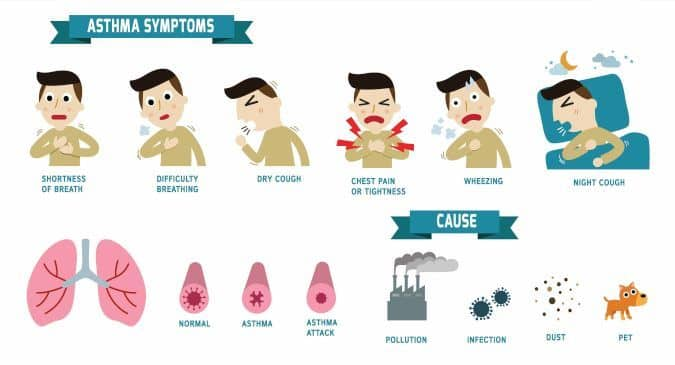Science Class 6EP
martes, 19 de marzo de 2019
lunes, 4 de febrero de 2019
lunes, 7 de enero de 2019
THE RESPIRATORY SYSTEM
The respiratory system is the system in the human body that enables us to breathe.
The act of breathing includes:
- Inhaling and exhaling air in the body.
- The absorption of oxygen from the air in order to produce energy.
- The discharge of carbon dioxide, which is the byproduct of the process.
The exchange of gases takes place through the membrane of the pulmonary alveolus, which always contains air: oxygen is absorbed from the air into the blood capillaries of the action of the heart circulates it through all the tissues in the body. At the same time, carbon dioxide is transmitted from the blood capillaries into the alveoli and then expelled through the bronchi and upper respiratory tract.
The inner surface of the lungs where the exchange of gases takes place is very large , due to the structure the air sacs of the alveoli.
THE ACT OF BREATHING
During inhalation - the muscles contract:
Contraction of the diaphragm muscle - causes the diaphragm to flatten, thus enlarging the chest cavity.
Contraction of the rib muscles - causes the ribs to rise, thus increasing the chest volume.
The chest cavity espands thus reducing air pressure and causing air to be passively drawn into the lungs. Air passes from the high pressure outside the lungs to the low pressure inside the lungs.
The chest cavity espands thus reducing air pressure and causing air to be passively drawn into the lungs. Air passes from the high pressure outside the lungs to the low pressure inside the lungs.
During exhalation - the muscles relax:
- The muscles are no longer contracting, they are relaxed.
- The diaphragm curves and rises, the ribs descend - and chest volume decreases.
- The chest cavity contracts thus increasing air pressure and causing the air in the lungs to be expelled through the upper respiratory track. Exhalation, too, is passive. Air passes from the high pressure in the lungs to the low pressure in the upper respiratory tract.
Parts
- Lungs
- Trachea
- Brochiole
- Alveoi
- Bronchus
- Nasal cavity
- Oral cavity
- Nostril
- Larynx
- Pharynx
The structures of the respiratory system interact with structures of the skeletal, circulatory, and muscular systems to help you smell, speak, and move oxygen into your bloodstream and waste out of it.
Fun facts:
- Only about 21% of room air is oxygen.
- We lose 12 oz. (1 oz. is similary to 28 gr.) of water daily through respiration.
- Adults breathe about 12-15 times per minute while newborns breathe about 30-60 times per minute.
- Mouth breathers tend to have more illnesses, sore throast and ear infections, this is thought to occur because the air is not filtered by nose first.
- Your left lung is often smoller than the right to allow room for the heart.
DIGESTIVE SYSTEM
PARTS:
- Mouth: digestión stars in the mouth. Then the teeth crush the food and then mix it with saliva.
- Esophagus: the food traverls down the esophagus to the stomach.
- Stomach: in the stomach, the food mixes with gastric juices.
- Liver: the liver produces a liquid called bile that helps break down food.
- Small Intestine: the food goes into the small intestine. Here it mixes with bile from the liver. Nutrients are absorbed here and they pass into the blood.
- Large intestine: the undigestied food passes into the large intestine. There it´s transformed into feaces.
- Rectum: finally, the feaces pass through the rectum and leave the body though the anus.
ILLNES:
- Constipation: when people have hard stools or have problems passing stools.
- Diarrhea: Diarrhea is when you pass loose or watery stool.
- Gallstones: are hard deposits that form inside the gallbladder. Gallstones may be as small as a grain of sand or as large as a golf ball.
- Hepatits B: Hepatitis B is irritation and swelling (inflammation) of the liver due to infection with the hepatitis B virus (HBV).
RELATIONSHIP:
- Relationship with the respiratory system starts with that the upper part of both are the mouth and the pharynx, the digestive system uses the mouth and pharynx to chew food into smaller particles and swallow so the food can be digested and nutrients can be excreted. The respiratory system uses the mouth and pharynx to breath in oxygen and sen it to the lung.
- Circulatory System: the digestive system works very closely with the circulatory system to get the absorbed nutrients distributed through your body. The circulatory system also carries chemical signals from your endocrine system that control the speed of digestion.
- Excretory System: the digestive system also works in parallel with your excretory system (kidneys and urination). While the digestive system collects and removes undegisted solids, the excretory system filters compounds from the blood stream and collects them in urine. They are closely connected in controlling the amount of water in your body.
FUNCTION:
The function of
the digestive system is digestion and absorption. Digestion is the breakdown of
food into small molecules, which are then absorbed into the body. The digestive
system is divided into two major parts: The digestive tract (alimentary canal)
is a continuous tube with two openings: the mouth and the anus.
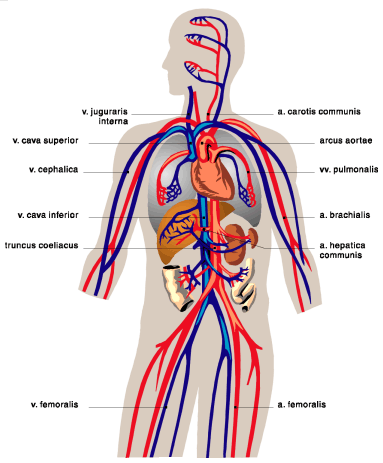 CIRCULATORY
CIRCULATORY SYSTEM
HOW DOES IT WORK ??
The circulatory system is a system that manage our body's and passes the blood and the nutrients to the vessels and the blood vessels help us to live, because the blood are necesary to the organs and to the heart.
PARTS:
There are someone of parts of the circulatory system
1- Aorta. 2- Pulmonary arteries. 3- Descending aorta. 4- Femoral artery.
5- Superior vena cava. 6- Pulmonary veins. 7- Inferior vena cava. 8- Femoral vein. 9- Veins. 10- Arteries and capillares.
VEINS:
Veins are blood vessels that carry blood toward the heart. Most veins carry deoxygenated blood from tissues back to the heart.
VARICOSE AND SPIDER VEINS:
The varicose and spider veins are swollen, twisted veins that usually appear on the legs, but also can form in other parts of the body.
EXAMPLES OF THE VARICOSE VEINS:
1-Hemorroids
2-Varicles
WHY ARE THEY FORMED??
Varicose veins form because the valves in the veins that should prevent blood from flowing backwards are not working as they should.the increased amount of blood in the vein pushes against the vein walls, and the vein gets bigger.
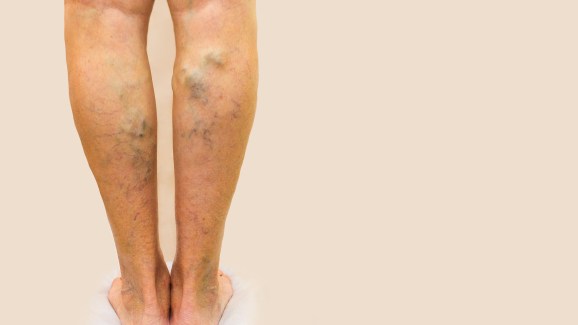 TYPES OF VEINS:
TYPES OF VEINS:Arteries, Capillares ,Varicose and Spider.
ARTERIES:
Arteries carry oxigen-rich blood away from the heart to all of the body's tissues. They branch several times, becoming smaller and smaller as they carry blood farter from the heart and into organs.
CAPILLARES:
These are small, thin blood vessels that conect yhe arteries and the veins. Their thin walls allow oxigen, nutrients, carbon dioxide, and other waste products pass to and from cells.
ILLNESES OF THE CIRCULATORY STSTEM:
There are no symptoms with high blood pressure, wich is why it's often called
''THE SILENT KILLER''.
ATHEROSCLEROSIS:
Also kown as hardening of the arteries, occurs when plaque builds up on the walls of your arteries and evetually bloks of flow.Plaque is made of choresterol, fat, and calcium.
CORONARY ARTERY DISEASE:
Indicates that the plaque buildup in your arteries has caused the arteries to narrow and harden. Blood clots can further blook the arteries.
 Of the vascular diseases the most common is atherosclerosis, that is, fat caps that obstruct the veins and arteries, mainly the arteries, because they handle a high pressure blood flow and are more seriously affected. That is when there is a loss of blood flow to the organs.
Of the vascular diseases the most common is atherosclerosis, that is, fat caps that obstruct the veins and arteries, mainly the arteries, because they handle a high pressure blood flow and are more seriously affected. That is when there is a loss of blood flow to the organs.Over the years, we can all acumulate a little fat in the arteries. However, when there is significant deficit of oxigen.
There are circumstances of risk that can cause the arteries to be in this way:

 high blood pressure, high blood choresterol levels, smoking, diabetes, obesity, stress, sedentary livestyle, as well as hereditary factors.
high blood pressure, high blood choresterol levels, smoking, diabetes, obesity, stress, sedentary livestyle, as well as hereditary factors.WHAT HAPPENS WHEN A CHILDREN SUCK THEIR ARMS AND THEV GET PURPLE AND RED??
What happens is that the blood acumulates in the plie of the suking and pick a little of color, usually lats at most a week and oftenhappens to children aged two to four years.
IN THE VENTRICULAR SYSTOLE, VALVES ATRIO-VENTRICULAR CELLS ARE CLOSED, WHERE DOES THE BLOOD COME FROM??
For the pulmonary arteries and the aorta.
WHAT ARE THE CAVITIES OF THE HEART??
Ventricle left and right, atrium left and right.
WHAT HAPPENS DURING DIASTOLE??
The heart dilates and fills with blood.
WHAT IS THE MAJOR CIRCULATION??
Is the one that goes from the right ventricle to the left atrium.
THE RESPIRATORY SYSTEM
RESPIRATORY SYSTEM
How does it work?
The respiratory system is made up of the organs and other parts that control breathing. Its most important job is to bring oxygen into your body and get rid of carbon dioxide. But, your respiratory system also helps you make noises. When you breathe, air moves over your vocal cords and causes them to vibrate.Parts
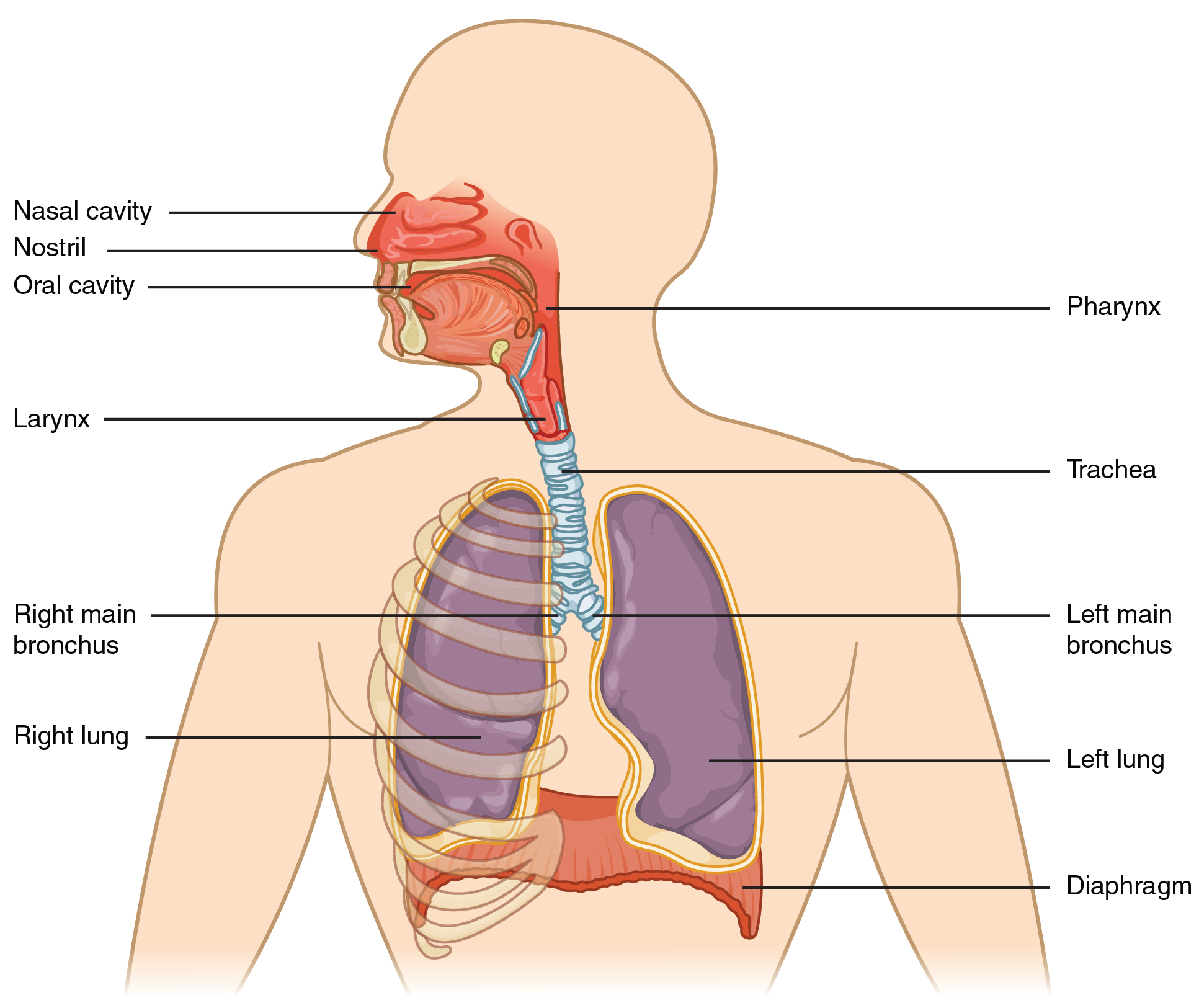
Nasal cavity: The nasal cavity is the inside of your nose. It is lined with a mucous membrane that helps keep your nose moist by making mucus so you won't get nosebleeds from a dry nose. There are also little hairs that help filter the air you breathe in, blocking dirt and dust from getting into your lungs.
Nostril: either of two external openings of the nasal cavity in vertebrates that admit air to the lungs and smells to the olfactory nerves.
Oral cavity: the part of the mouth behind the gums and teeth that is bounded above by the hard and soft palates and below by the tongue and by the mucous membrane connecting it with the inner part of the mandible.
Pharynx: the membrane-lined cavity behind the nose and mouth, connecting them to the oesophagus.
Larynx: It's a tube about 2 inches (5cm) long in adults. It sits above the windpipe (trachea) in the neck and in front of the food pipe. The food pipe in the upper part of the neck is called the pharynx.
Trachea: It's a tube about 4 inches long and less than an inch in diameter in most people. The trachea begins just under the larynx (voice box) and runs down behind the breastbone (sternum). The trachea then divides into two smaller tubes called bronchi: one bronchus for each lung.
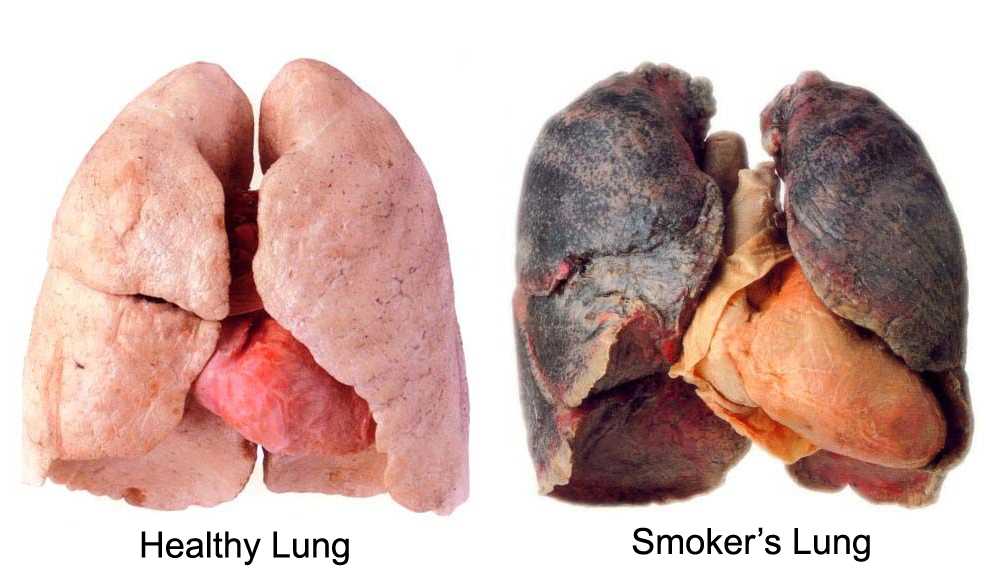

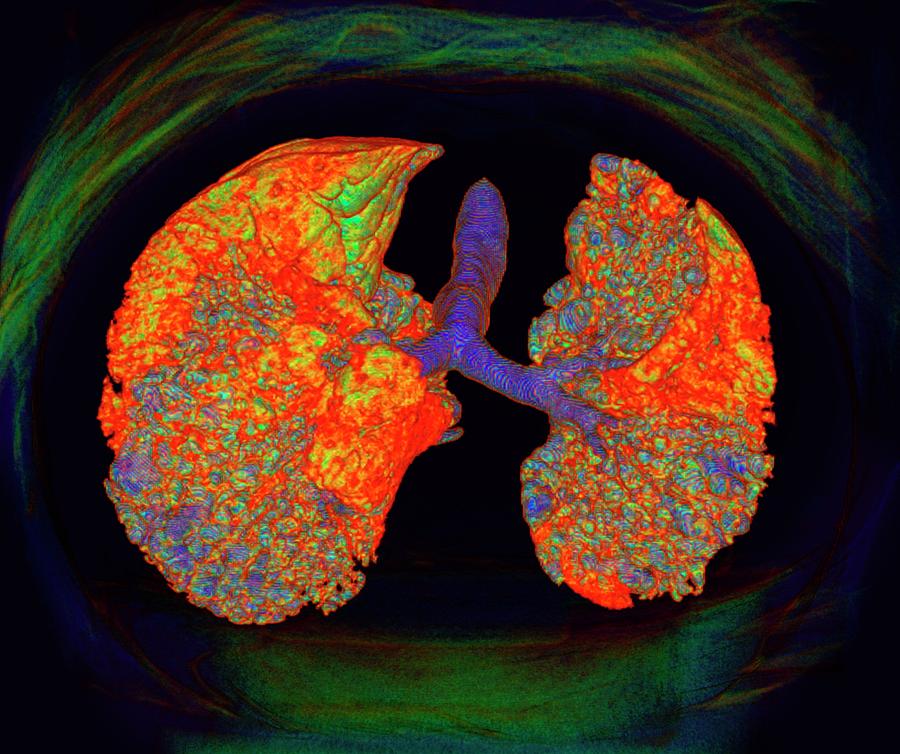
Nostril: either of two external openings of the nasal cavity in vertebrates that admit air to the lungs and smells to the olfactory nerves.
Oral cavity: the part of the mouth behind the gums and teeth that is bounded above by the hard and soft palates and below by the tongue and by the mucous membrane connecting it with the inner part of the mandible.
Pharynx: the membrane-lined cavity behind the nose and mouth, connecting them to the oesophagus.
Trachea: It's a tube about 4 inches long and less than an inch in diameter in most people. The trachea begins just under the larynx (voice box) and runs down behind the breastbone (sternum). The trachea then divides into two smaller tubes called bronchi: one bronchus for each lung.
The trachea is composed of about 20 rings of tough cartilage. The back part of each ring is made of muscle and connective tissue.
Bronchus: is a passage of airway in the respiratory system that conducts air into the lungs. The first bronchi to branch from the trachea are the right main bronchus and the left main bronchus.
Lungs: are a pair of spongy, air-filled organs located on either side of the chest (thorax). The trachea (windpipe) conducts inhaled air into the lungs through its tubular branches, called bronchi. The bronchi then divide into smaller and smaller branches (bronchioles), finally becoming microscopic.
Diaphragm: is a thin skeletal muscle that sits at the base of the chest and separates the abdomen from the chest. It contracts and flattens when you inhale. This creates a vacuum effect that pulls air into the lungs.
ILLNESSES
Asthma
Asthma is defined as a common, chronic respiratory condition that causes difficulty breathing due to inflammation of the airways. Asthma symptoms include dry cough, wheezing, chest tightness and shortness of breath. Dr. Meyer says there is a major connection between environmental allergies and asthma. Allergic reactions, infections and pollution can all trigger an asthma attack.
Lung Cancer
Most often, the cancer develops in the main part of the lungs near the air sacs. DNA mutations in the lungs cause irregular cells to multiply and create an uncontrolled growth of abnormal cells, or a tumor. These tumors interfere with the regular functions of the lungs.
The most common risk factor for lung cancer is cigarette smoke. Other risk factors include radon exposure, workplace exposure, including asbestos and diesel fumes, secondhand smoke, air pollution and radiation exposure from frequent CT scans of the chest.

Pneumonia
Pneumonia is a common lung disease caused by an infection in the air sacs in the lungs. The infections can be bacterial, viral or fungal. Most people can recover in one to three weeks, but for certain people, pneumonia can be extremely serious and even life-threatening.

Emphysema
Emphysema is a serious respiratory disease, which is another form of COPD. The most common cause is smoking. Those who suffer from emphysema have trouble exhaling air from their lungs. Cigarette smoke damages the air sacs in the lungs to a point where they can no longer repair themselves. 

Pulmonary fibrosis
is a lung disease that occurs when lung tissue becomes damaged and scarred. This thickened, stiff tissue makes it more difficult for your lungs to work properly. As pulmonary fibrosis worsens, you become progressively more short of breath.
Interesting facts
- Hairs in the nose help clean and warm the air we breathe.
- Women and children breathe at a faster rate than men.
- Lungs are the only human organ that can float in water! Each of your lungs contains about 300 million balloon-like structures called alveoli, which replace the carbon-dioxide waste in your blood with oxygen. When these structures are filled with air, they make lungs float.
- Your left lung is smaller than your right (which leaves room for your heart!)
- A person at rest usually breathes between 12 to 15 times a minute. Newborns up to 6 weeks breathe between 30 to 60 times per minute!
- The word "Lung" originates from 13th century European language, it means "light" which refers to the weight of the organ when considering its size. (because there is so much air in there, and air is light!
VIDEO
Excretory sistem
The excretory system
Is the system of the body that performs the function of excretion, the process in which the waste is expelled.
Is the system of the body that performs the function of excretion, the process in which the waste is expelled.
The parts of the Excretory system are two kidneys,Aorta,Bladder,Urethra,Renal Vain,Ureter.
The kidneys accumulate the waste that our body does not need, and once it has accumulated it transports it to the ureter.
The ureter carries waste from the kidneys to the bladderAnd the Bladder expuls the wastes through the urethra.
illnesses
There are some illness related to the excretory system, for example the nephrosis that is an illness, in wich the kiddneys doesnt filter the wastes correctly and it can make stones in youre kiddneys. And they can be solve with out medicines, but some other stones may be dangerous.
The Nocturia is other illness that make you expuls the wastes in the night than in the day, it is caused by diabetes or drink alcohol. The solutions are to eat healthy food not to drink alcohol and to have a healthy boddy( doing sport, drink lot of water etc)
The Nocturia is other illness that make you expuls the wastes in the night than in the day, it is caused by diabetes or drink alcohol. The solutions are to eat healthy food not to drink alcohol and to have a healthy boddy( doing sport, drink lot of water etc)
Suscribirse a:
Comentarios (Atom)




